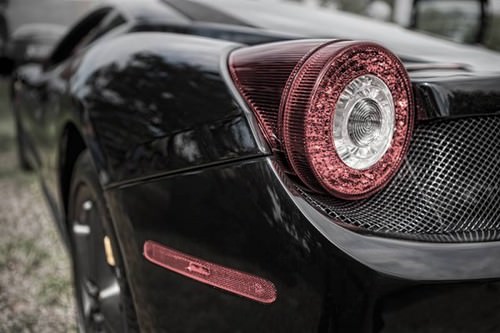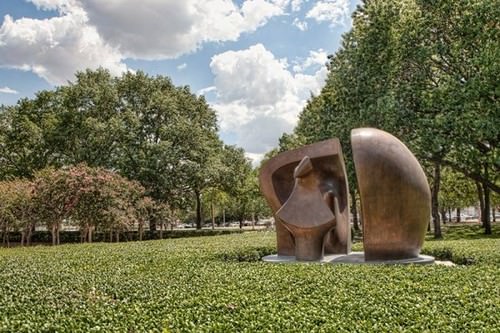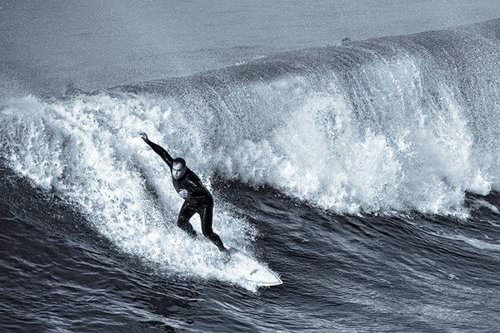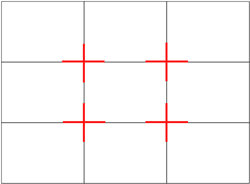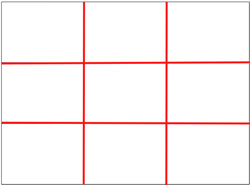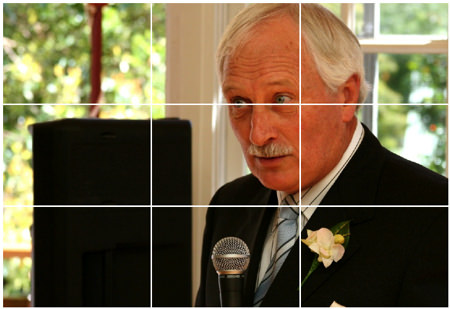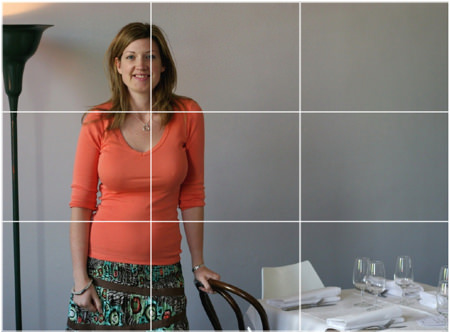Fibonacci编号,(审查)黄金平均值和摄影
章节大纲
-
First, some video reviews on Fibonacci Numbers.
::首先,一些关于Fibonacci数字的视频评论。Nature by Numbers:
::以数字表示的自然性质 :The Golden Mean:
::黄金平均值:By now you should know that this is NOT a conspiracy theory or fuzzy math. This is a real aspect of composition that has been used by historical famous artists and architects, and Fortune 500 companies. When applied to photography, this ratio can produce aesthetically pleasing compositions that can be magnets for the human sub-conscious. When you take the sweet spot of the Fibonnaci Ratio and recreate it four times into a grid, you get what looks to be a rule of thirds grid. However, upon closer inspection you will see that this grid is not an exact splitting of the frame into three pieces. Instead of a 3 piece grid that goes 1+1+1=frame, you get a grid that goes 1+.618+1=frame. Here are a few examples a Phi grid placed over some images that I’ve used it on in the past…
::现在,你应该知道,这不是一个阴谋理论或模糊的数学。 这是历史著名艺术家和建筑师以及财富500家公司所使用的构成的真面目。 当应用到摄影时, 这个比例可以产生令人喜悦的成份, 可以吸引人类潜意识。 当你把Fibonnaci 比率的甜点再复制四倍到一个网格中, 你就会得到看起来像是3/3格规则的东西。 但是, 仔细检查后你会发现, 这个网格不是将框架分割成3个块的准确的。 而不是一个1+1+1=框架的3个网格, 而是一个1+618+1=框架的网格。 这里有几个例子, 一个Phi网格是我过去曾经使用过的一些图象上的网格 。In the above example, I placed the slightly more dominant eye of the horse on one of the Phi intersections. Consider that if I had placed a rule of thirds grid over this photo and lined the eye up with that, the head would be crowding the left side of the frame. In this photo, the head isn’t center, it’s not crowding either side. It’s just right, would you agree? Let’s take a look at another…
::在上述例子中,我把马的占优势的眼神放在了皮十字路口的一处。 想想如果我在这张照片上加上一条三分之三的格子,并用这幅格子把眼睛钉上,头部就会挤满了框架的左侧。 在这张照片中,头部不是中间的,不是中间的。这是正确的,你同意吗?让我们看看另一张...This one is slightly different. If you’re a REAL stickler for details, you may have noticed that there is a slight difference between the intersecting lines of the Phi graph, and the sweet spot of Phi itself. In this image, I made sure to align the head of my subject within the spiral and placed the left eye approximately over the sweet spot. Ok, moving on…
::这是略有不同的。 如果你是一个真正的细节粘贴者, 你可能已经注意到Phi图的交叉线与Phi本身的甜点之间略有区别。 在这个图像中,我确保我对象的头部在螺旋内固定,并把左眼大约放在甜点上方。 好的, 继续...In this photograph, from Key West, I lined up the horizon with the top line of the Phi grid. In my opinion, when you line up the horizon with a rule of thirds grid, the separation is too…obvious. I think it would leave a bit too much of what isn’t the subject in the image. In this photo, the sky and clouds are the perfect compliment to what I’m trying to convey in the photo: The church on the bottom right, and the famous Duval street on the left. But with any more sky than is already present in the photo, the viewer might think the sky is actually the subject. Here’s one more…
::在这张照片中,我从基韦斯特(Key West)用Phi 网格的顶端线排在地平线上。 在我看来,当你用三分网格规则排在地平线上时,隔开太明显了。 我认为这会使图像中不是主题的部分留下太多。 在这张照片中,天空和云层是我试图在照片中表达的内容的完美补充:右下方的教堂和左边著名的Duval街。 但是,如果有比照片中已经存在的更多的天空,观众可能会认为天空是主题。这里还有一幅...In this example, I used multiple lines on the Phi grid for my final composition. I lined up the doors with both vertical lines, as well as the bottom horizontal line. This provided for a perfect amount of ceiling to lead the viewers eye to the door.
::在这个例子中,我用Phi网格上的多条线作为我最后的构成。我用垂直线和底水平线把门排成一行。这为观众提供了完美的上限,引导观众看门。Here’s a few more examples without the grid. See if you can imagine the grid over the images and determine why the image was composed the way it was.
::这里还有几个没有网格的例子。 看看您能否想象图像上的网格, 并确定为什么图像是按原样构造的。
Conclusion
::结论 结论 结论 结论 结论Hopefully, this article has shed some light on a somewhat mysterious subject in the world of photography. Fibonacci’s Ratio is a powerful tool for composing your photographs, and it shouldn’t be dismissed as a minor difference from the rule of thirds. While the grids look similar, using Phi can sometimes mean the difference between a photo that just clicks, and one that doesn’t quite feel right. I’m certainly not saying that the rule of thirds doesn’t have a place in photography, but Phi is a far superior and much more intelligent and historically proven method for composing a scene.
::希望这篇文章能给摄影界一个有点神秘的话题带来一些启发。 Fibonacci 的“比率”是制作你照片的有力工具,不应该把它视为与“三分法”的微小区别。 虽然网格看起来相似,但使用Phi有时意味着仅仅点击的照片与不完全正确的照片之间的区别。 我当然不是说“三分法”在摄影中没有位置,但Phi是更优越、更聪明、更具有历史证据的表达场景的方法。If you’d like to start incorporating this powerful composition tool into your photography, you’re in luck! I’ve included a PNG overlay of both the Fibonacci Spiral and the Fibonacci Grid. Just click to start using them. These overlays are for use in Photoshop. Just place them into the file you are working on, then scale them to the correct size of the image.
::如果您想要开始将这个强大的合成工具纳入摄影中, 您就很幸运了 ! 我已经将Fibonacci Spiral 和 Fibonacci 网域的 PNG 覆盖了。 只要点击即可开始使用它们。 这些覆盖用于照片店。 把它们放进您正在处理的文件, 然后将其缩放到图像的正确大小 。(above from article at )
:比《...年...月...日的文章)
Counter
::柜柜台A commenter on the above article highlights the fact that this method is only one choice of many at the photographer's disposal,
::一位评论者强调,这种方法只是摄影师可以选择的许多选择之一,Oddly, I agree with both the advocates and opponents of using this as a composition tool. A Golden-Ratio overlay only shows you why compositions work when using it, but that's not the full picture. Composition in photography (or any art-form) is much much much more than just following some simple set of rules that can be mimicked by anyone. They can come close by using Phi most of the times, but in the example photos posted, I disagree, those compositions do NOT work to the best advantage for the subjects contained. Each one missed the mark in one aspect or another.
::奇怪的是,我同意倡导者和反对者都同意用它来作为合成工具。 Golden-Ratio 重叠只向您展示了为什么组合在使用它时起作用,但这不是全景。摄影(或任何艺术形式)的构成远远不只是遵循某些简单的规则,任何人都可以模仿这些规则。他们可以大部分时间使用Phi 来接近他们,但在张贴的示例照片中,我不同意,这些组合对所包含主题没有最大的好处。每个部分都错过了标记。Composition is much more than putting the center of someone's eye on a mathematically accurate "sweet spot", or a linear aspect hitting a Phi line. The shapes in that photo; the colors, the tones, the action, the mood; ALL must be taken into account on how it will fit into the Phi-phactor.
::构成远不止是将某人眼中的中心放在数学精确的“ 甜点 ” 上, 或直线的一面击中菲线线。 照片中的形状; 颜色、 音调、 动作、 情绪; 在如何与 Phi-phator 相容时, 必须考虑到所有的形状 。The surfer? Sorry, he shouldn't be trying to fall out of the bottom of the photo.
::抱歉,他不应该试图从照片底部掉下来The sculpture? Sorry, its shape needs to be "and"ed fractally with the bulbous shapes of the trees in dynamic symmetry.
::雕塑?
Other elements of photography composition include perspective, line of sight in the image, color, interpretation, intent, etc. Recognition of this method when used and application of this method in your own photography is a very basic step in criticism of photograph as defined in Criticizing Photographs: An Introduction to Understanding Images by Terry Barrett, pg 3.
::摄影成份的其他要素包括视觉、图像的视线、颜色、解释、意图等。 在使用这一方法时承认该方法,并在你自己的摄影中使用该方法,这是批评照片的一个非常基本的步骤,正如《批评照片:Terry Barrett对了解图像的介绍》第3页所定义的。Criticism is informed discourse about art to increase understanding and appreciation of art. This definition includes criticism of all artforms, including dance,music, poetry, painting, and photography. 'Discourse' includes talking and writing. 'Informed' is an important qualifier that distinguishes criticism from mere talk and uninformed opinion about art.
::批评论是对艺术的知情论述,以增进对艺术的理解和欣赏。这一定义包括对所有艺术的批评,包括舞蹈、音乐、诗歌、绘画和摄影。“课程”包括谈话和写作。“内建”是一个重要的限定词,将批评与单纯的谈话和对艺术的不知情见解区分开来。The Simplification of the Golden Ratio into the Rule of Thirds
::将黄金比率简化为第三代规则In the examples above, the dividing lines on the photographs are not perfectly dividing the photograph. In the Rule of Thirds, images are equally divided. This provides a good rule of thumb for beginning photographers. (below information from )
::在以上的例子中,照片上的分界线并不完全分隔照片。在第三规则中,图像是平分的。这为刚开始拍摄的摄影师提供了一个很好的拇指规则。 (下面是 )Perhaps the most well known principle of photographic composition is the ‘ Rule of Thirds ‘.
::也许最著名的摄影成份原则是`第三者规则 ' 。The “Rule of Thirds” one of the first things that budding digital photographers learn about in classes on photography and rightly so as it is the basis for well balanced and interesting shots.
::“第三代规则”是数字摄影师在摄影课程中最先学到的,这是正确的,因为它是非常平衡和有趣的拍摄的基础。I will say right up front however that rules are meant to be broken and ignoring this one doesn’t mean your images are necessarily unbalanced or uninteresting. However a wise person once told me that if you intend to you should always learn it first to make sure your breaking of it is all the more effective!
::我将直言不讳地说,规则注定要被打破,而无视这一规则并不意味着你的形象必然是不平衡的或毫无兴趣的。 然而,一个聪明的人曾经告诉我,如果你打算这样做,你应该总是先学会,以确保你打破规则的效果更高。What is the Rule of Thirds?
::第三规则是什么?The basic principle behind the rule of thirds is to imagine breaking an image down into thirds (both horizontally and vertically) so that you have 9 parts. As follows.
::3/3规则的基本原则是想象将图像向下折成3/3(横向和纵向),以便有9个部分。如下所示。As you’re taking an image you would have done this in your mind through your viewfinder or in the LCD display that you use to frame your shot.
::当您正在拍摄一个图像时, 你就会在脑海中通过屏幕或 LCD 显示器做到这一点,With this grid in mind the ‘rule of thirds’ now identifies four important parts of the image that you should consider placing points of interest in as you frame your image.
::以这个网格, “三分之三规则”现在确定了形象的四个重要部分,Not only this – but it also gives you four ‘lines’ that are also useful positions for elements in your photo.
::不仅如此, 也给你们四条“线”, 这些线对于照片中的元素也是有用的位置。The theory is that if you place points of interest in the intersections or along the lines that your photo becomes more balanced and will enable a viewer of the image to interact with it more naturally. Studies have shown that when viewing images that people’s eyes usually go to one of the intersection points most naturally rather than the center of the shot – using the rule of thirds works with this natural way of viewing an image rather than working against it.
::理论是,如果你在十字路口或纵横线上点出兴趣点,让照片变得更加平衡,并使图像的观众能够更自然地与图像互动。 研究显示,在观看人们眼睛通常最自然地出现在交叉点而不是镜头中间的图像时 — — 使用三分法则可以自然地观看图像,而不是与图像相对照。In addition to the above picture of the bee where the bee’s eye becomes the point of focus here are some of examples:
::除了上面关于蜜蜂的景象外, 蜜蜂的眼睛成为这里的焦点, 以下是一些例子:In this image I’ve purposely placed the head of my subject on one of the intersecting points – especially his eyes which are a natural point of focus for a portrait. His tie and flower also take up a secondary point of interest.
::在这张图中,我有意将我主题的头部放在交叉点上 — — 特别是他的眼睛 — — 这对肖像来说是自然的焦点。 他的领带和花朵也占了次要利益点。In this shot I’ve placed the subject along a whole line which means she is considerably off center and therefore creating an additional point of interest. Placing her right in the center of the frame could have resulted in an ‘awkward’ shot.
::在这场拍摄中,我把主题放在了一条整条线上,这意味着她相当地远离中心,因此产生了额外的关注点。 将她放在框架的中间可能导致“尴尬”的镜头。In a similar way a good technique for landscape shots is to position horizons along one of the horizontal lines also as I’ve done with the following shot (I’ll let you imagine the lines).
::类似地貌拍摄的好手法是沿水平线定位地平线,Using the Rule of Thirds comes naturally to some photographers but for many of us takes a little time and practice for it to become second nature.
::有些摄影师自然会使用第三代规则, 但对于我们许多人来说,In learning how to use the rule of thirds (and then to break it) the most important questions to be asking of yourself are:
::在学习如何使用三分之三规则(然后打破这一规则)时,需要问自己的最重要问题是:-
What are the points of interest in this shot?
::拍这张照片有什么意义? -
Where am I intentionally placing them?
::我故意把它们放在哪里?
Once again – remember that breaking the rule can result in some striking shots – so once you’ve learnt it experiment with purposely breaking it to see what you discover.
::再一次记住,打破这一规则可能导致一些打击性射击 — — 所以一旦你学会了它有意识地打破它来观察你发现的东西。Lastly – keep the rule of thirds in mind as you edit your photos later on. Post production editing tools today have good tools for cropping and reframing images so that they fit within the rules. Experiment with some of your old shots to see what impact it might have on your photos.
::最后 — — 在你以后编辑照片时,请记住第3/3规则。 邮编编辑工具今天有很好的裁剪和重新配置图像的工具,以便它们符合规则。 实验一下你的一些旧照片,看看这些照片会对你的照片产生什么影响。Create your own!
::创造你自己的!Using the PhiMatrix software ( ) or the measures in the resources section, compose your own photograph using Phi.
::使用PhiMatrix软件()或资源部分的措施,用Phi拍摄自己的照片。 -
What are the points of interest in this shot?




